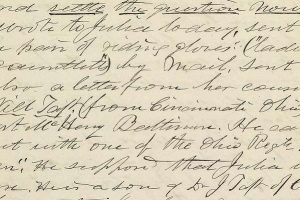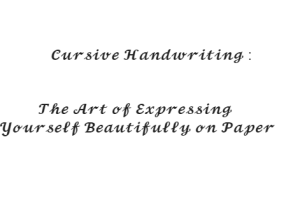Introduction
In today’s digital world, cursive handwriting is a dying art form. However, it remains an essential skill for many reasons. Cursive handwriting can help develop fine motor skills, boost memory retention, and improve writing speed. Additionally, it adds a personal and elegant touch to any written communication. In this article, we will explore some tips and techniques for cursive handwriting practice.
Why Practice Cursive Handwriting?
Many people may question the need to practice cursive handwriting in today’s world. However, there are still several compelling reasons to do so. Cursive handwriting can improve the legibility and speed of your writing. It can also help develop fine motor skills and enhance cognitive abilities.
Research has shown that practicing cursive handwriting can improve memory retention, as it involves a combination of motor skills, thinking, and language. In a study published in Psychological Science, researchers found that students who wrote in cursive had better memory retention than those who wrote in print.
Moreover, cursive handwriting is a unique and personal form of communication that can add an elegant and sophisticated touch to any written document. It can also enhance your creativity and provide a sense of accomplishment when you see your progress.
How to Practice Cursive Handwriting
To improve your cursive handwriting, you need to practice regularly and use proper techniques. Here are some tips to help you practice cursive handwriting:
1. Start with the basics
Begin by practicing individual letters and then move on to joining them to form words. Use a cursive handwriting chart or worksheet to guide you.
2. Use proper posture and grip
Sit up straight with your feet flat on the ground, and hold the pen or pencil with a relaxed grip. Use your arm to move the pen instead of just your fingers.
3. Write slowly and carefully
Focus on writing each letter correctly and neatly. Don’t rush or try to write too quickly.
4. Practice regularly
Set aside a few minutes each day to practice cursive handwriting. Make it a part of your daily routine.
5. Use helpful resources
There are many helpful resources available to help you practice cursive handwriting. Use online worksheets, apps, or practice books to improve your skills.
Common Mistakes to Avoid
When practicing cursive handwriting, there are several common mistakes to avoid:
1. Sloppy or illegible writing
Make sure your writing is legible and neat. Use a ruler or guide to keep your writing straight and even.
2. Inconsistent letter formation
Practice each letter carefully to ensure consistent formation. Use a cursive chart or worksheet to guide you.
3. Rushing or writing too quickly
Don’t rush through your writing. Take your time and write slowly and carefully.
Conclusion
Cursive handwriting may be a dying art form, but it remains an essential skill. Regular practice can improve your writing speed, cognitive abilities, and memory retention. With the tips and techniques outlined in this article, you can enhance your cursive handwriting skills and add a personal and elegant touch to any written communication.









Add Comment